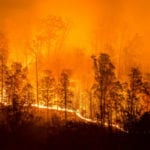 Weird Stuff
Weird Stuff  Weird Stuff
Weird Stuff  Our World
Our World 10 Ways Your Christmas Tree Is More Lit Than You Think
 Movies and TV
Movies and TV The 10 Coolest Stars to Set Sail on The Love Boat
 History
History 10 Things You Didn’t Know About the American National Anthem
 Technology
Technology Top 10 Everyday Tech Buzzwords That Hide a Darker Past
 Humans
Humans 10 Everyday Human Behaviors That Are Actually Survival Instincts
 Animals
Animals 10 Animals That Humiliated and Harmed Historical Leaders
 History
History 10 Most Influential Protests in Modern History
 Creepy
Creepy 10 More Representations of Death from Myth, Legend, and Folktale
 Technology
Technology 10 Scientific Breakthroughs of 2025 That’ll Change Everything
 Weird Stuff
Weird Stuff Ten Bizarre Facts About The Doge Meme
 Our World
Our World 10 Ways Your Christmas Tree Is More Lit Than You Think
 Movies and TV
Movies and TV The 10 Coolest Stars to Set Sail on The Love Boat
Who's Behind Listverse?

Jamie Frater
Head Editor
Jamie founded Listverse due to an insatiable desire to share fascinating, obscure, and bizarre facts. He has been a guest speaker on numerous national radio and television stations and is a five time published author.
More About Us History
History 10 Things You Didn’t Know About the American National Anthem
 Technology
Technology Top 10 Everyday Tech Buzzwords That Hide a Darker Past
 Humans
Humans 10 Everyday Human Behaviors That Are Actually Survival Instincts
 Animals
Animals 10 Animals That Humiliated and Harmed Historical Leaders
 History
History 10 Most Influential Protests in Modern History
 Creepy
Creepy 10 More Representations of Death from Myth, Legend, and Folktale
 Technology
Technology 10 Scientific Breakthroughs of 2025 That’ll Change Everything
10 Lesser-Known Historical Events That Shook Our View of Safety
We move through life trusting that the systems around us—the buildings we enter, the products we use, the infrastructure we rely on—are designed to keep us safe. It’s a belief so ingrained that we hardly ever question it. But every now and then, something happens that shatters this sense of security. These aren’t the headline-grabbing disasters we’ve all heard about. Instead, they’re quieter tragedies—events that flew under the radar but still had a profound impact on our understanding of safety.
These lesser-known incidents exposed hidden vulnerabilities that many of us never imagined. They didn’t dominate the news cycle or become household stories, but for those affected, they were life-changing. In each case, the aftermath revealed shocking flaws in the systems we depend on, forcing society to confront the uncomfortable truth that safety is far more fragile than we’d like to believe.
As we explore these ten events, we’ll see how they upended our assumptions about what it means to be safe. These stories remind us that safety isn’t a given—it’s a delicate balance that requires constant vigilance. By learning from these overlooked disasters, we can gain valuable insights into how to prevent such tragedies in the future and ensure a safer world for all.
Related: 10 People Who Survived Multiple Disasters and Deadly Situations
10 When a Train Defied the Station (1895)
On a seemingly ordinary day in 1895, the Montparnasse Station in Paris became the site of one of the most dramatic and shocking train accidents in history. The Paris-Granville Express, running late and speeding to make up for lost time, hurtled into the station at a dangerous pace. But what happened next was beyond anyone’s worst expectations. The train’s brakes failed, and the locomotive plowed right through the station’s buffers, smashed through the walls, and ended up dangling from the second floor, its nose buried in the street below.
Miraculously, only one person—a woman selling newspapers outside—lost her life, struck by falling debris. The passengers on board escaped with minor injuries, but the terrifying sight of a train hanging from the station’s façade was enough to leave a lasting impression on the public. The incident was captured in now-iconic photographs that circulated widely, highlighting just how vulnerable even the most solid structures can be when safety measures fail.
This accident wasn’t just a freak occurrence; it exposed serious flaws in railway safety that led to crucial changes in braking systems and regulations. The Montparnasse crash reminds us that even the most trusted systems can fail, shaking our confidence in the safety we often take for granted.[1]
9 The Day Safety Was Locked Away (1991)
In 1991, a fire at the Imperial Food Products plant in Hamlet, North Carolina, exposed the deadly consequences of prioritizing profits over people. A faulty fryer sparked the blaze, but the real tragedy unfolded as workers tried to escape—only to find the doors locked. The management had padlocked the exits to prevent theft and keep out union organizers, a decision that would cost 25 lives.
This horrific event wasn’t just about one company’s negligence; it was a wake-up call to a much bigger problem. The plant had never been inspected by safety regulators, and local officials, desperate for jobs, turned a blind eye to dangerous working conditions. The fire revealed how deeply the pursuit of “cheap” had compromised worker safety, resulting in devastating results.
Though the Hamlet fire led to some changes, it quickly faded from the national spotlight, leaving behind a haunting reminder of the risks we take when safety is sacrificed for savings. It forced many to rethink the real cost of “cheap” and how easily lives can be lost when corners are cut.[2]
8 The Day a River Turned Toxic (2005)
In November 2005, an explosion at a petrochemical plant in Jilin, China, unleashed a toxic disaster that few saw coming. A massive wave of chemicals, including benzene and nitrobenzene, spilled into the Songhua River, a crucial water source for millions. As the contamination spread, towns along the river were thrown into chaos, with Harbin, one of the largest cities in northeastern China, forced to shut off its water supply for days.
The toxic plume stretched over 93 miles (150 kilometers), making its way downstream and crossing into Russia, sparking international tension. Despite efforts to dilute the pollution, the chemicals remained dangerously high, leaving residents fearing for their health and safety. The spill exposed how vulnerable even essential resources like water can be to industrial accidents and how ill-prepared the system was to handle such a crisis.
This disaster wasn’t just a wake-up call for China—it was a stark reminder to the world of how easily our most vital resources can be compromised. It forced many to reconsider the true cost of industrial progress and the importance of safety measures that protect both people and the environment.[3]
7 Poison in a Bottle (2022)
In 2022, The Gambia faced a nightmare no parent should ever endure—nearly 70 children died after taking cough syrup that was supposed to ease their pain. Instead, it turned out to be poison in a bottle. The syrups, imported from India, were found to contain dangerously high levels of toxic chemicals like diethylene glycol and ethylene glycol. These substances caused acute kidney failure in the young victims, revealing just how vulnerable we are when safety nets fail.
The syrups came from Maiden Pharmaceuticals, a company with a troubling track record in India. Despite past warnings and blacklisting in some regions, the company continued to export its products, with The Gambia becoming one of its latest victims. Local authorities in The Gambia didn’t test the syrups, trusting that they met safety standards. This tragic mistake highlighted the risks that come when we assume safety measures are in place without verifying them.
This disaster forced many to confront the uncomfortable truth. When it comes to medicines, especially in low-income countries, we can’t afford to take safety for granted. It was a heartbreaking reminder that even the most basic safeguards can fail, with devastating consequences.[4]
6 A Halloween Night Turned Tragic (1963)
Halloween night in 1963 at the Indiana State Fairgrounds Coliseum was supposed to be full of fun and excitement, with families gathered to enjoy the “Holiday on Ice” show. But as the skaters glided into their final formation, disaster struck. A propane gas leak from a rusty tank in the concession area ignited, sending a massive explosion ripping through the arena. In an instant, joy turned to horror as 74 people were killed, and nearly 400 more were injured.
The aftermath was a scene of chaos and devastation. Concrete chunks and debris rained down, burying some in a crater created by the blast, while others were thrown onto the ice. The arena, once filled with laughter, became a somber morgue as rescuers struggled to help the injured and identify the dead. The incident shook the city to its core, exposing the deadly consequences of neglecting safety standards in public spaces.
This tragedy forced many to reconsider the safety of public venues and the importance of strict safety regulations. The explosion wasn’t just a freak accident; it was a wake-up call that highlighted the risks of cutting corners when it comes to protecting lives.[5]
5 The Fiery Wake-Up Call in Cleveland (1944)
On October 20, 1944, Cleveland’s east side was rocked by a disaster that few saw coming. At the East Ohio Gas Company, a storage tank holding liquid natural gas began leaking, turning the area into a ticking time bomb. The gas mixed with the air, and soon after, a catastrophic explosion erupted, sending a wave of fire through the neighborhood. Moments later, a second tank exploded, engulfing the area in a hellish blaze.
The fire spread with terrifying speed, destroying homes, businesses, and vehicles. The gas seeped into the city’s sewers, causing additional explosions that ripped through streets and blew manhole covers sky-high. By the time the inferno was under control, 79 homes and two factories were gone, and 130 lives had been lost. The sheer scale of the destruction left Cleveland residents and safety officials in shock, questioning the safety of gas storage and industrial practices.
This tragic event was more than just a fire; it was a wake-up call that exposed serious flaws in industrial safety. It forced a reevaluation of how dangerous substances were handled and stored, highlighting the need for stricter safety measures. The East Ohio Gas explosion remains a haunting reminder of how quickly things can go wrong and the importance of never taking safety for granted.[6]
4 The Day a School Became a Deathtrap (1908)
On March 4, 1908, what started as a routine school day at Lakeview Elementary in Collinwood, Ohio, quickly turned into a nightmare. A fire erupted in the basement of the overcrowded building, and within moments, the wooden structure was engulfed in flames. Panic spread as children and teachers desperately tried to escape, but blocked exits and narrow stairways turned the school into a deadly trap. Tragically, 172 children and two teachers never made it out, their lives cut short in what became one of the deadliest school fires in U.S. history.
The aftermath was heartbreaking. Families searched frantically through the rows of small bodies, hoping against hope not to find their own child among them. The entire community was paralyzed by grief, with businesses closing and streets lined with funerals for days. The fire left an indelible scar, not just on Collinwood but on the nation as a whole.
The Collinwood School Fire was a devastating wake-up call that forced the country to confront the flaws in its school safety standards. It led to major changes in building codes and fire safety regulations, ensuring that such a tragedy would never happen again. This horrific event highlights the importance of vigilance when it comes to the safety of our children.[7]
3 The Secret Tragedy at Baikonur (1960)
On October 24, 1960, at the Baikonur Cosmodrome, a tragic accident unfolded that the Soviet Union kept hidden for decades. The Soviet military was in a rush to test the R-16 intercontinental ballistic missile, and in their haste, safety protocols were pushed aside. With Marshal Mitrofan Nedelin overseeing the operation, nearly 250 people were dangerously close to the fully-fueled rocket when disaster struck.
A fatal combination of technical failures and human error caused the rocket’s second stage to ignite prematurely. In an instant, a massive explosion consumed the launch pad, turning it into an inferno. The fireball killed 92 people, many of whom were burned beyond recognition, leaving behind a scene of horror that was almost too shocking to comprehend. The Soviet government swiftly covered up the disaster, keeping it a secret for nearly 30 years.
The Nedelin disaster was a sobering reminder of the catastrophic consequences that can result from neglecting safety in the pursuit of technological progress. It shook the confidence of those involved in the Soviet space program and exposed the dangers of cutting corners, even in the most critical operations. The secrecy surrounding the event only added to its dark legacy, showing just how far some will go to hide their failures.[8]
2 When a Village’s Worst Fears Came True (1966)
On the morning of October 21, 1966, the Welsh village of Aberfan faced a tragedy that would haunt it forever. A towering coal waste tip, long teetering on the edge of safety, suddenly collapsed after days of heavy rain. In an instant, a massive wave of black sludge roared down Merthyr Mountain, crashing directly into Pantglas Junior School. Children who had just begun their day were buried under tons of debris, along with their teachers. Despite frantic rescue efforts, 116 children and 28 adults lost their lives.
The community had long feared the coal tip that loomed over their homes and school. Warnings about its dangers had been ignored by those in power, and the price of that neglect was paid in innocent lives. The disaster struck at the heart of Aberfan, leaving a wound that would never heal and a painful reminder of what happens when safety is sacrificed for convenience.
The Aberfan disaster forced a painful reckoning with the failures of the National Coal Board and the broader system that allowed such a catastrophe to happen. It shook the nation’s trust in industrial safety practices and underscored the vital importance of listening to communities when they raise concerns.[9]
1 The Dam That Couldn’t Hold Back Disaster (1975)
In August 1975, Henan province in China was struck by a disaster that no one saw coming. Typhoon Nina, a storm of unprecedented strength, stalled over the region, dumping an unimaginable amount of rain. The Banqiao Dam, built to withstand what was thought to be the worst possible flood, simply couldn’t take the pressure. In the early hours of August 8, the dam gave way, unleashing a wall of water that tore through the countryside, wiping out entire towns in its path.
The sheer force of the flood was terrifying. A wave as high as 33 feet (10 meters) surged forward at incredible speed, obliterating everything in its way. The town of Daowencheng was completely destroyed, and in the aftermath, the death toll reached a staggering 171,000 people, making it one of the deadliest dam failures in history. The disaster wasn’t just a natural tragedy—it was a brutal reminder that even our most advanced engineering has limits.
The Banqiao Dam failure forced China to confront the vulnerabilities in its infrastructure and rethink how it approached flood control. It shook the very foundations of what we thought was safe, proving that when nature pushes back, the consequences can be catastrophic.[10]








